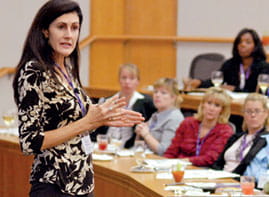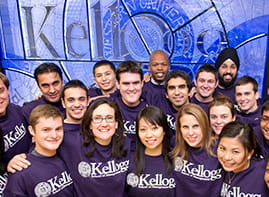Going beyond the spreadsheet
Professor Sid Deshmukh sets a high bar for his <i>Analytical Decision Modeling</i> class: He seeks to make it fun
By Chris Serb ’097/20/2010 - Spending a few hours with Excel is tantamount to getting a root canal for many people. So it speaks volumes about Sudhakar “Sid” Deshmukh that his course Analytical Decision Modeling is so highly regarded among Kellogg School students.
In this Operations elective, Deshmukh teaches various ways to frame, set up and solve questions about resource allocation, risk analysis, data analysis, and forecasting using Microsoft Excel, as well as various tools and add-ins. Despite the focus on spreadsheets (the course is alternately known as Spreadsheet Modeling for Managerial Decisions), Deshmukh insists that this is not a course in Excel.
“I like to think that my students learn how to think about problems in a logical, systematic way,” says Deshmukh, who is the Charles E. Morrison Professor of Decision Sciences. “I am disappointed if a student tells me that he or she learned a lot of Excel in my course, because that is not the main purpose — it is a side benefit. Modeling involves simplifying or breaking up a problem into smaller components connected together, and that is what I hope they learn.”
During one recent class, Deshmukh’s lesson reflected this approach. The lecture focused on a complex question: how to value an option, over time and under uncertainty. But to get there, Deshmukh led his students on a journey. First, he showed a compound interest model over time, with no uncertainty; then, he introduced the role of risk, with a stock pricing model; and finally, he based an option valuation off that stock model.
As Deshmukh illustrated his moves on a laptop connected to the classroom projector, his students dutifully followed along on their own laptops, click-click-clicking their way through the models.
This methodical approach might seem tedious at first, but it resonates with students. “Professor Deshmukh focuses on building the basic blocks of the model without being distracted by details,” says Kanna Potharlanka ’09, who took the class in the spring of 2009. “This procedure, although understood by many, needs discipline, and this is where Professor Deshmukh has added the most value to students: solving complex analytical problems by thinking in a simple and methodical way.”
After walking his students through the option valuation model and simulating 1,000 different random valuations for the same option over the course of one year, Deshmukh types a strange series of symbols and numbers into the neighboring cells.
“This is the Black-Scholes model for option pricing. It’s a complicated formula that involves much more math than we’re prepared for,” Deshmukh says. “But after we run this simulation we can draw a picture” — he quickly plots both the simulations and the Black-Scholes model onto a scatter graph — “and we can see that the lines lie on top of each other. That tells me that our simulation and the theory are consistent.”
Deshmukh’s goal is not to teach the students how to prove the Black-Scholes formula. After all, that problem has already been solved, and this is an MBA-level operations class, not PhD level mathematics.
“Theoretical solutions require a lot of math beyond the scope of the MBA background,” Deshmukh says. “For managers, it’s more important to be able to build a simulation model that yields an answer that is close to the theoretical one. Spreadsheet analysis helps us understand the underlying theory better.”
In addition to option valuation, Deshmukh walks his students through several other problems each quarter that mirror specific real-world situations: loan amortization; monopoly pricing; optimal product mix; budget allocation; portfolio planning; and an “optimal stopping” model for when to accept a job offer, with defined weekly search costs (a very relevant model for Deshmukh’s second-year students).
Deshmukh’s passion for these topics and his ability to keep the material fresh continues to inspire his students. “Professor Deshmukh brings a very interactive style to his teaching, which keeps the class engaged throughout,” says Jarrod Cady ’10, who also took the class in the spring of 2009. “The fact that his class provides such useful tools for making decisions only makes the experience that much better.”
Although Deshmukh introduces some fairly specific cases and applications, he notes that parroting these models isn’t enough. “I call the course Analytical Decision Modeling, not Models, because I like to stress the importance of the thought process of structuring problems,” Deshmukh says.
To expand students’ ability to structure problems, Deshmukh requires teams to come up with their own decision analysis models each quarter — “I want new examples, not too narrow, not too broad, not the same as anything you’ve seen but not too far either,” he explains to the class. “The ideal is that you start thinking about these things seriously and creatively.”
Qualities like “creativity” might seem even less likely than “humor” to pop up in a Decision Modeling class, but this is one of Deshmukh’s main goals for his students.
“Improved Excel skills are of course a concrete takeaway from the course, but I also like to think that the students become better at thinking about problems more analytically, systematically and logically,” Deshmukh says. “That is hard to quantify and therefore verify, but they do uniformly say that this is one of the most practical courses they have taken.”






